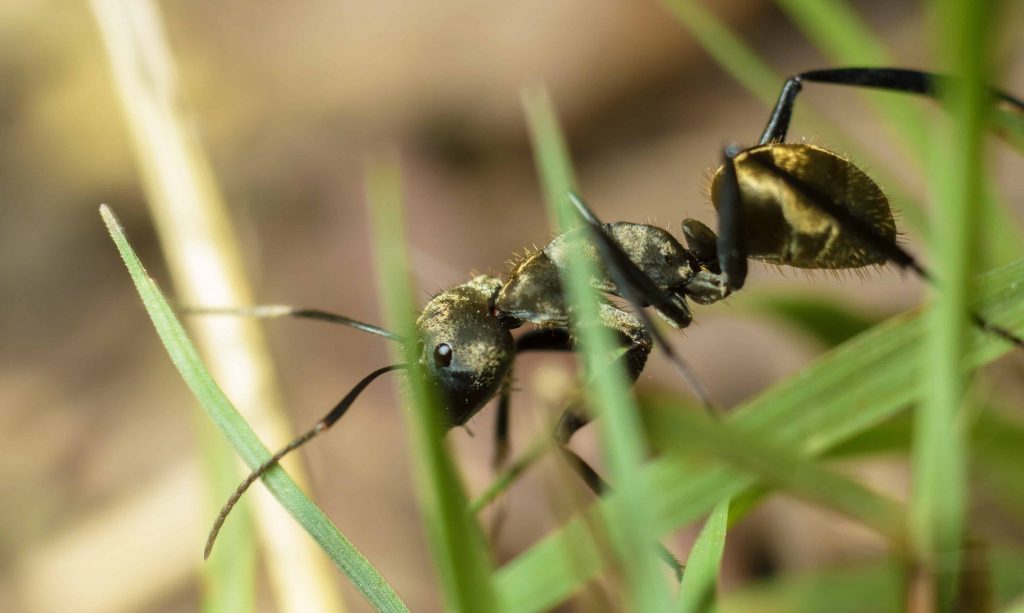How to Get Rid of African Lovegrass in Your Lawn
African Lovegrass (Eragrostis curvula) is a tufted, grassy weed that’s most prevalent in Australian pastures and grazing land, but it can impact home lawns too. Originally ...

Funnel Ants are common all across Australia, and while you may not recognise the name immediately, you’ll have come across their uniquely shaped nests in sandy soils all over the country. Their mounds can pop up in lawns if the conditions are right, doing substantial damage underground including destabilising the soil layer with their networks of underground tunnelling, or causing damage to the leaf canopy thanks to the sprawling funnel-shaped entrances to their nests.
Luckily, keeping a healthy lawn is a great deterrent and will allow your lawn to recover quickly in the event of Funnel Ant damage, and they can be effectively treated using affordable and readily available insecticides.
 Funnel ants (Aphaenogaster spp.) are named for their characteristic nests, which have small, conical entrances that resemble tiny funnels. These ants are relatively small, with a body length ranging from 4 to 6 millimetres, and are usually light brown or reddish-brown.
Funnel ants (Aphaenogaster spp.) are named for their characteristic nests, which have small, conical entrances that resemble tiny funnels. These ants are relatively small, with a body length ranging from 4 to 6 millimetres, and are usually light brown or reddish-brown.
Funnel ants are widespread throughout Australia, especially in tropical and subtropical regions where they thrive in sandy and loose soil types. They are most active during warmer months, particularly in Spring and Summer, when they establish and expand their colonies.
Like other ants, Funnel Ants have a complex life cycle that begins with eggs. The eggs hatch into larvae, which develop into pupae before maturing into adult ants. During their reproductive phase, winged males and females leave the nest for their mating flight. After mating, the fertilised female starts a new colony by laying eggs, which hatch into worker ants responsible for foraging, nest-building, and expanding the colony. This life cycle is typically completed within several weeks, depending on environmental conditions.
The most obvious sign of a funnel ant infestation is the appearance of their distinctive nests. These funnel-shaped entrances can vary in size but are generally small, circular depressions in the soil, often accompanied by mounds of displaced dirt around the opening. These nests can make your lawn uneven, creating tripping hazards and bare patches where grass has been killed by the wide openings to their nests. If left untreated, heavy infestations can destabilise the soil, potentially causing larger ground collapses in areas with high ant activity.
If Funnel Ants are wrecking havoc on your lawns, you can control their populations using an insecticide, or via some slower, natural methods.
Funnel Ants can be controlled using a fast-acting insecticide like Rumbler, whose active ingredient bifenthrin is registered to control most common lawn pests.
They can also be controlled using Monarch G, which uses fipronil as the active ingredient. Fipronil is harder for lawn grubs to detect which – it could be argued – leads to greater efficacy.
Insecticides are serious business and need to be treated with respect, which includes following the manufacturers recommended application rates and using any and all safety equipment they recommend.
Rumbler is applied in liquid form, diluted between 12-44mL/100sq.m depending on the size of the nest, whereas Monarch is a granular product and is applied at 1.2kg/100sq.m. They don’t need to be applied to the whole lawn, just in a radius around the nest (30cm for Rumbler and 56cm for Monarch).
Natural remedies are also an option for those who don’t like the idea of using chemical-based insecticides.
If you prefer a natural approach, there are some options to discourage funnel ants from invading your lawn. Diatomaceous earth, a fine powder made from fossilised algae, can be sprinkled around ant nests. It works by damaging the ants’ exoskeletons, leading to dehydration.
Additionally, strong natural smells like vinegar or even certain essential oils like peppermint, tea tree, and eucalyptus are natural ant deterrents. Mixing these oils with water and spraying them around the nests disrupts the ants’ natural pheromone trails back to their nest, and can diminish populations by making it harder for them to find their way home.
Funnel Ants can cause problems in your home lawn, but like all lawn pests they can be easily managed through the use of insecticides or a variety of natural methods. Mitigate bug damage and give your lawn the best chance of recovery for a bug outbreak by maintaining a year-round fertiliser and supplement schedule, and keeping it in healthy condition with regular mowing and watering.
To control Funnel Ants in your lawn, visit myhomeTURF’s online store for a selection of insecticides and other lawn care products.